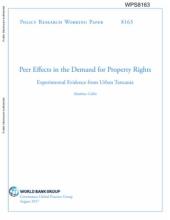Land Library
Welcome to the Land Portal Library. Explore our vast collection of open-access resources (over 74,000) including reports, journal articles, research papers, peer-reviewed publications, legal documents, videos and much more.
/ library resources
Showing items 46 through 54 of 4525.Climate risk represents an increasing threat to poor and vulnerable farmers in drought-prone areas of Africa. This study assesses the fertilizer adoption responses of food insecure farmers in Malawi, where Drought Tolerant (DT) maize was recently introduced.
This study uses data from the complete computerization of agricultural leases in Malawi, a georeferenced farm survey, and satellite imagery to document the opportunities and challenges of land-based investment in novel ways.
This paper investigates the presence of endogenous peer effects in the adoption of formal property rights.
Transit subsidies in the urban area of Buenos Aires are high, amounting to a total of US$5 billion for 2012.
This paper evaluates the effect of the Rural Capacity Building Project, which aimed at promoting growth by strengthening the agricultural service systems in Ethiopia and by making them more responsive to smallholders' needs.
Despite the spread of automation and new supply chain management paradigms, logistics remains dependent on a rather specific set of skills and competencies, whether for managerial, administrative, or blue-collar jobs, such as trucking or warehousing.
These case studies were developed as part of the World Bank's Results Monitoring and Evaluation for Resilience Building Operations (ReM&E) project, which aims to develop and increase the application of systematic, robust, and useful approaches to monitoring and evaluation (M&E) for resili
This paper revisits the decades-old puzzle of the inverse plot-size productivity relationship, which states that land productivity decreases as plot size increases.
Research has provided robust evidence for the use of GPS technology to be the scalable gold standard in land area measurement in household surveys. Nonetheless, facing budget constraints, survey agencies often seek to measure with GPS only plots within a given radius of dwelling locations.









